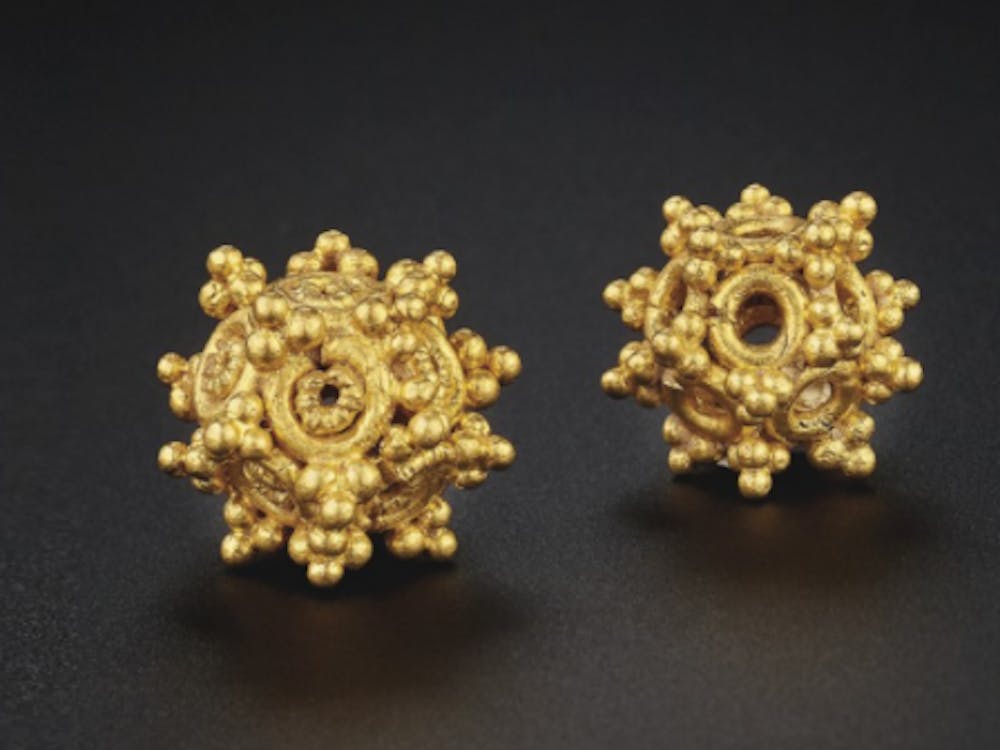If the two thumb-size polyhedral gold beads didn’t have an accompanying museum tag explaining their origin, many would not recognize them as Han dynasty (25-220 CE) adornments from China. Indeed, when most people think of Chinese antiques, their minds go immediately to beautiful Qinghua porcelain. Little attention has been paid to Chinese gold — until now. Curated by Assistant Professor of History of Art & Architecture Sarah Laursen and now on exhibit at the Museum of Art, “Lost Luxuries: Ancient Chinese Gold” is an attempt to showcase these ancient Chinese gold artifacts.
Laursen became fascinated with Chinese gold when she was completing her dissertation at the University of Pennsylvania, where she worked with ancient Chinese gold artifacts from Liaoning, a province in northeast China. After completing her doctorate, she broadened her research to look at Chinese gold across the country as new archeological sites emerged. That’s when she met conservator Donna Strahan, with whom she explored the technology behind the Chinese Gold Cicada Plaque, named after its shape.
The Cicada plaque inspired more curiosity in other potentially forgotten gold objects that American museums have in their collections. “There was so much [information on Chinese gold artifacts] in the US collection that nobody knew that was there,” said Laursen. In order to meet international standards, all antiquities purchased by the museum must have left the country of origin before 1970. To learn where qualified antiques are located today, she and her students went through domestic historical records, including the study of 20,000 records of the Caro Archive at Institute of Fine Arts of New York University.
Laursen was surprised by some of her findings. “I found out that the person behind that the single largest collection [of Chinese gold] in the United States was really a woman who never gets any credit,” she said. “She was referred to as Mrs. Charles Stinson instead of her actual name, which was Helen Pendelton Winston. That is tragic to me.”
Ms. Stinson donated numerous gold objects to the Minneapolis Institute of Art after the passing of her husband, who was a Minneapolis native and traveled extensively in Europe.


Han Dynasty gold beads purchased by the college museum of art.
After preparatory work, Laursen visited the Minneapolis Institute of Arts, the Nelson-Atkins Museum of Arts, the Arthur M. Sackler Gallery and the Metropolitan Museum of Art in 2017 to look at objects in person. Many objects of this exhibit, such as a Zhou dynasty necklace, a Han dynasty gold box, a Sui/Tang dynasty Buddhist sutras and a Tang dynasty Rosette, are on loan from these respective museums.
When Laursen thought she had a full checklist for the exhibition, unexpected news struck: Christie’s would hold an auction titled “Masterpieces of Early Chinese Gold and Silver” in September 2019. After viewing its catalogue, she was immediately drawn to two polyhedral gold beads, originally from Dr. Johan Carl Kempe’s collection in Sweden. “I would do anything to have those,” she recalled herself thinking. True to her words, the museum had the winning bid on a Xianbei gold plaque and two polyhedral gold beads from the auction. The museum did not disclose the objects’ price to The Campus, but according to Christie’s public records, the museum paid $37,500 for the plaque and $60,000 for the beads.
The exhibition not only highlights the beauty of the showcased objects, but also zeroes in on goldsmith techniques and recent archaeological discoveries to create a comprehensive learning experience for its visitors with different technologies such as Esri StoryMaps and a Holosonics Audio Spotlight.
The use of technology in exhibitions stemmed from 2020 Vision: Seeing the World Through Technology, an initiative under Andrea Rosen, curator of the Fleming Museum of Art in 2016. Laursen explained that the curators decided on the strategy because technology can be adapted to fit a variety of museum types, science institutes, history museums, art galleries and many more.
The curation of the exhibition has been extremely gratifying, according to Laursen. She said that this exhibition, in addition to raising public awareness, also sparked other museum curators’ interest in Chinese gold.
“The most rewarding is knowing that I’ve changed the fate of those objects,” she said.
“Lost Luxuries: Ancient Chinese Gold” will remain on display at the Middlebury College Museum of Art until April 19.

Rain Ji '23 is a managing editor of The Campus. She previously served as an Arts & Culture editor.
She is majoring in International and Global Studies with a concentration in the Middle East and North Africa. Previously, she studied abroad in Amman at the University of Jordan. Outside of academics, she enjoys watching Criminal Minds and skiing.




